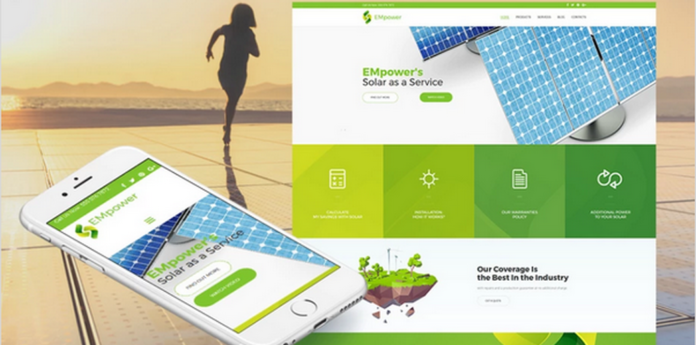The energy industry is developing very fast. Thus, the demand for specialized web design services is growing.
Energy industry web design focuses on creating websites that are particularly suitable for the unique needs of energy companies, from renewable energy providers to oil and gas corporations. Practically, it is very important to follow trends important for the energy industry so that you don’t lose your edge.
These websites must be highly functional. In spite of the fact that the websites should also be visually appealing, the most important thing is that they are functional and optimized for user experience. In addition, they should also reflect the industry’s technical and regulatory complexities and challenges.
Understanding Energy Industry Web Design
In order to create, you need to understand it first. Energy industry web design requires a perfect mixture and balance of creative innovation and technical expertise. Some of the key components include:
- Visual Storytelling: In the world of social networking, we have to be competitive and fast. Meaning that people’s attention span is very low, and that is why we need to pay special attention to how we can share a story with a broader audience. We only have a couple of seconds to captivate the observer’s attention, and how we tell a story is very important. High-quality graphics and videos can effectively communicate extremely complex energy concepts.
- Compliance: It sounds boring, but except for creativity, we need to be very technically precise. Many energy companies operate under strict regulations, so websites must comply with legal and security standards.
- User Experience (UX): The energy industry has a great and different set of audiences. Therefore, intuitive navigation is critical. The website needs to be understood by investors, engineers, etc.
- Responsive Design: Many people are fighting to comprehend and actually grasp the essence of what responsive design means. One of the great examples is that with mobile usage rising, sites must have flawless performance across all devices.
By becoming a master of these components, designers can create websites that not only look professional but also drive engagement and trust. People like the feeling of security and being included, and that is why interactive websites can draw a lot of positive attention.
Building the Right Skill Set
Once you enter the world of energy industry web design, you immediately start with acquiring the complementary skills. In case you are proficient in CSS and HTML, you are already taking big first steps. However, you should also have in mind and not forget that JavaScript is essential. Also, by being familiar with content management systems like Drupal or WordPress or Drupal you are equally valuable for your set of skills.
In addition, comprehending SEO best practices ensures that energy company websites rank well in search results. One of the most important things designers should also study is the energy sector’s terminology and trends to create relevant content.
Courses in UX/UI design or certifications in renewable energy basics can provide a competitive edge. Even though there is a debate around courses these days elaborating that courses are not enough, have in mind that they are excellent to create a strong basis, and later you will be able to build your knowledge a lot easier.
Last but not least, though, it is important to mention that collaborating with industry professionals or joining energy-focused design forums or communities can also offer valuable insights into client expectations and emerging technologies.
How to Stay Ahead of Industry Trends in Energy Industry Web Design
The energy sector companies are what job interviewers popularly call dynamic working environments. One of the fastest-paced and ever-evolving industries is the energy sector. The main force behind the wheel is technological advancements. However, these days, it is not only about being technologically literate, but you also need to pay special attention to sustainability and climate change.
For web designers who specialize in energy industry web design, staying on top of the latest trends is essential to delivering important, efficient, and impactful solutions. One major trend is the focus on how to brand green energy. Here we have renewable energy companies that prioritize eco-friendly aesthetics. How does that look like actually? The answer is that it often involves using minimalist layouts. Although it seems like something superficial or rather unnecessary, it can help a lot and add the atmosphere of ecological awareness. For instance, earthy color palettes and imagery that mirror sustainability, such as solar panels or wind turbines. These design choices put an accent on a company’s commitment to being environmentally responsible while creating a visually cohesive brand identity at the same time.
What has recently advanced as a key trend is the increasing demand for data visualization in energy websites. Companies often need to present extremely complex data, such as energy production metrics or carbon footprint reductions. All that, of course, should be easy to understand by all types of readers because otherwise it would be pointless. Interactive dashboards, dynamic charts, and real-time analytics tools make users feel engaged and important, while also having important work done as data is processed in a meaningful manner. In addition, AI integration is becoming more and more popular, with chatbots and AI-driven customer support tools improving the user experience.
Networking and Marketing Your Services
Breaking into the energy industry web design also includes strategic networking, as in today’s world, everything is about connections. Make sure to attend energy conferences whenever possible. Do not be a stranger and join LinkedIn groups, or if you are brave enough, partner with energy consultants to build connections.
Content marketing, such as blogging about energy web design trends, can position you as an expert. Also, if you are offering free audits or templates to energy startups, there is a stronger probability that you will also attract potential clients.
In conclusion
The energy industry is growing very fast, and at the same time, it demands customized web design that balances visual effects and appeal, functionality, and compliance. In order to be successful in energy industry web design, you must be technically equipped with suitable knowledge.
However, only technical skills are not enough as you should also have a trend awareness, and strategic networking. By mastering data visualization and green branding while collaborating with different people, designers can create websites with purpose and greater meaning that meet the sector’s evolving needs.

